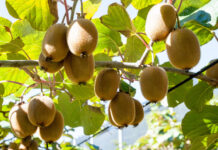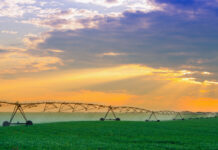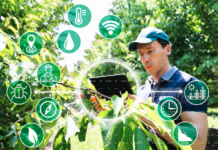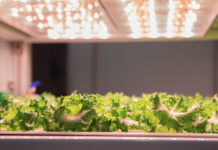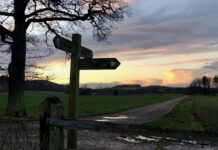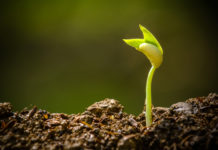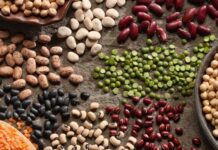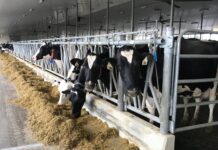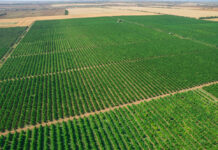[Music fades up, sounds of farm animals, tractors, computer clicks and digital noise] [Music fades out]
Hannah Senior: Our global systems of food and agriculture are broken in many ways. We’re exceeding our planetary boundaries with extractive and unsustainable farming methods. And the global food system is frequently plagued with poor working conditions, poor profitability for farmers and food waste. Human civilization was built off the back of agriculture. But with the human population increasing dramatically, we have to find a way to feed more mouths with less.
So far in this podcast series, we’ve explored the complex challenges facing agriculture, including labour shortages, poor farmer profitability, and the environmental toll that modern agriculture takes on the planet. We’ve dived into why agriculture needs entrepreneurs to help drive change, and discussed the ecosystem around those startups, which is so critical for success. Then, in the last episode, I spoke to farmers about how they engage with AgTech startups, the barriers to adoption of new technology, and learned more about farmer led support for innovative new businesses.
In this episode, we’re going to hear from entrepreneurs themselves, about their perspectives on starting an AgTech company.
[Music fades in and out. A tractor drives by]
As with farmers, entrepreneurs are not a homogenous lot. The type of innovation, the sector, they’re targeting their geographic location, their personal and professional networks; all of these things and more have a dramatic effect on their experience of startup life. For the purpose of this podcast, I chose to speak to entrepreneurs who’ve been on the journey for a
few years now. All of their companies are now revenue generating after years of research and development. This means that they all have experience of raising investment, developing and finessing their products, and then launching them to the market. Timing is everything. And their individual experiences are in many ways a function of the timing of their ventures. They got their start when there wasn’t as much focus on this sector. And they’ve been growing their businesses, at exactly the same time as investor enthusiasm for AgTech and the entrepreneurial ecosystem around the sector has developed. If they were starting their companies now, the experience might well be very different, in some ways positive in some negative. It also means, because three is such a small sample size, that there is survivor bias. These entrepreneurs all succeeded through skill and circumstance in raising money, achieving product market fit and creating a functioning team. And yet, despite the small sample size, we can still learn a lot from their experiences.
So to get things started, let’s meet the entrepreneurs and learn about the companies they’ve been developing. I first spoke to Ashwin Madgavkar, the founder and CEO of Ceres Imaging. The company was founded in 2014 in California, and now works with farms across the USA, Canada and Australia. I asked Ashwin to tell me a bit about what Ceres Imaging does.
Ashwin Madgavkar: What we do is help farmers optimize water, fertilizer and other critical inputs. We’ll fly above farms, we have a sensor that looks at different wavelengths of light. And we’ll analyze that using a computer vision and machine learning pipeline. And we’re able to show farmers which of their plants are overwatered or underwatered, where they may have a nutrient deficiency. We can predict areas of a farm that are more vulnerable to a pasture disease outbreak. So we’re providing all sorts of actionable insights to farmers, helping them be more efficient and, hence, more profitable as well as more sustainable.
I was originally inspired to start the company after seeing a multimillion dollar sensor designed by NASA that was being used in different biodiversity research at Stanford where I went to grad school, and I thought it could have really powerful applications in the agriculture industry if
we’re able to take that data set and turn it from academic tool into one for – productize it- into one for farming decisions.
Hannah Senior: Like so many entrepreneurs, Ashwin saw an opportunity where others did not.
Ashwin Madgavkar: I’ve always been passionate about energy and the environment. And I was working in bio energy, which led me into agriculture. And more specifically, I’d spent some time in Brazil, and Colombia in Latin America working on some large sugarcane farms. As you may know, a lot of sugarcane is refined into ethanol for the fuel supply. I saw how some of these large farms made decisions around chemical or fertilizer applications to their crops. And I was struck by how little data was collected or used in order to guide those decisions. And in general, I observed that farmers would apply these inputs with a healthy margin of safety, so to maximize yield, but weren’t able to get the granular data to customize how much they put on based on the soil type, or topography. So I thought this technology I saw at Stanford could be really powerful if it were turned into the right sort of tool for their needs.
Hannah Senior: Ashwin first developed his product using drones, but soon found that light aircraft were a more reliable and scalable option for the job at hand. They developed sensors that can be mounted onto the aircraft and flown over farmland collecting data for the farmer.
Ashwin Madgavkar: We also use satellite, some drone data, some weather data and multiple sources. We’re really agnostic to where the data comes from, but it’s all about the right tool for the right job. What really makes us differentiated after that is the analytics and the data. So we use a combination of different algorithms, like a deep learning algorithm to identify individual plant centers, we’ll use a variety of photogrammetry and other computer vision techniques. And then we’ll apply a set of crop models. And a lot of our core business is around water and irrigation optimization in specialty crops. But we have developed products for more than 40 different crops and geographies now, including corn, cotton, soy, potatoes, tomatoes, rice, and we’re not only doing water, but also have products for variable rate fertilizer application, pest and disease prediction, yield forecasting, among other things as well.
Hannah Senior: The second entrepreneur I talked with is Bethany Deshpande. Based in Nova Scotia, Canada, Bethany is the co-founder and CEO of SomaDetect, a company providing inline milk quality testing and animal health data for the dairy industry.
Bethany Deshpande: It’s an inline optical sensor technology, it’s powered by artificial intelligence and deep learning. What we do – we actually are collecting all kinds of data about quality of milk as it comes out of individual cows and some of the health factors of those animals. And we give that data, those analytics, back to farmers, and it allows them to have essentially, you know, 60, to 90 times more data, a much richer data set than they’ve ever had before. So that when we look at things like trends or changes that are happening from the individual cow level, to the pen level to the herd as a whole, they’re able to catch issues, whether those be issues with health, reproduction, etc, a lot earlier, and ultimately have healthier, more sustainable dairy operations.
Hannah Senior: One of the key data sets the company tracks is the somatic cell count in the milk, which can be used as an indicator of milk quality, but also an early indicator of the common disease, mastitis: an infection of the cows udder tissue.
Bethany Deshpande: That’s really common through the dairy industry, about one in five cows end up with mastitis. It’s the common cold of dairy animals. And so we are watching somatic cell counts for every single cow at every single milking. And so sometimes it’s this disease that happens very quickly, but often diseases sort of, you know, they build up, they happen over time. And so what we do is we help farmers know that they have that issue before it reaches the really serious stages.
Hannah Senior: Bethany’s background was in biology and climate sciences. And she had plenty of experience wrangling vast quantities of data. When her father, a biophysicist, developed a sensor that could see fat content levels in milk and somatic cell counts, Bethany saw an opportunity.
Bethany Deshpande: So I have a PhD in Biology and through that got to use a lot of different lab equipment and sensor technologies and so forth. And you run very quickly into the same challenge that we also have in agriculture, which is: it’s one thing to generate large amounts of data -I had massive data sets as a PhD researcher, but then it really comes down to how you use that data. So how we analyze it and so forth. And I think that type of technical background, the experience looking through, you know, terabytes and terabytes of different types of data and then bringing that together to have an overarching story, or an overarching idea of what’s happening, is absolutely critical in AgTech, just as it is across many different fields of biology.
I had done a number of entrepreneurial initiatives through my schooling and really had the opportunity to try out different experiences in entrepreneurship. I knew it was something I was interested in. And it was something that held lots of possibility. And so this really started as very much a side project with my dad, of getting his sensor into the hands of a potential market, essentially, which I thought would be fairly simple when we started. But of course, we learned, you know, agriculture, dairy is an incredibly complex system. And the technology itself, we also realized over time, when we added things like deep learning and AI, to this tech, it actually could do a lot more than what we started with.
Hannah Senior: The company was officially founded in 2016, and is now growing.
Bethany Deshpande: We’re a growth stage or scale up company. We have about 23 employees, full time employees, we have raised a major funding round from institutional investors and are just starting to generate our first revenues within the market.
Hannah Senior: The third entrepreneur I spoke to is the Australian, David Smith, the CEO and co-founder of Ceres tag, which uses smart air tags to track animals.
David Smith: Ceres Tag is the world’s first direct to satellite monitoring system for livestock, companion animals, wildlife and other animals as well. So we’ve developed a way to monitor the animals without any infrastructure required. Simply attach the sensor, and we can be monitoring the animals for traceability, provenance, and welfare. It only weighs 35 grams, it’s
got a twin pin attachment to the ear. This is for livestock. So on companion animals, as an example, that different configuration to go on a collar. A wildlife product is also very similar to the livestock one, so it’s a twin pin attachment.
The retention system is new. It’s five times greater braking force to get it apart. So once it attaches to the animal, it stays on for life. So it’s a lifetime traceability system, it then communicates directly from that ear tag to the satellite, and then the data comes down and into our platform. Once it’s in our platform, we then can disperse that information to other software, so herd management software systems.
The difference is that we’re not a closed system, we’re an open system. So we collaborate with lots of other people in the ecosystem, in the AgTech ecosystem, whether they be blockchain in herd management, whether they are researchers, whoever the case may be that wants the information.
So inside the tag is a GPS, so naturally location, and that records four to six times a day. So it’s fairly regular. So multi times daily. If you’ve got a herd, say, of 100, animals, they all reported a slightly different time. So you get this continuous flow, you can do heat maps, and where they are, the tag also has an accelerometer in it. So it’s measuring those movements and from those movements, you’re able to develop algorithms for health and behavior.
Hannah Senior: Unlike the other two entrepreneurs, David, a Materials Engineer in energy and infrastructure, did have some experience with agriculture, having grown up on a farm. It was while taking a break and visiting his wife and co-founders fifth generation cattle farming family, that they saw an opportunity.
David Smith: The fundamental thing was cattle theft. So we had some animals go missing off the property. And we needed to be able to track them if we’re going to get a result, like, to capture thieves or other matters. We know that finding your animals and knowing where they are and what they’re doing is just something that people wanted to have. And they didn’t want to spend lots and lots of money on infrastructure. You know, setting up towers and saying you
can communicate via all these terrestrial type communication systems is like it’s just long, laborious, you know? It’s it’s expensive to set up before you even put a tag on an animal, you’re spending tens of thousands, if not hundreds of thousands of dollars.
And so we decided that if we’re going to do this it had to be via satellite, because if you were to set up infrastructure and use traditional IoT systems, then as soon as they’re 10 kilometers down the road, you would lose them. Whereas our system, no matter where they are, no matter what time, we’re able to track them down. But with other systems, you’re going to spend all this money putting up towers before you even know that you’re wanting to use it, it makes no sense at all! We need to give them something that can be low cost to enter, you can just buy a box of, you know – for us, if you buy a box of 10, or a box of 24 tags, they are delivered to your door, you put them on the animal within an hour, you’re getting data about your animals. And if if you like what you see, and if you’re happy with what it does, then buy another box of 24 or, you know, scale it up to whatever you want it to be, you might want to do sentinel, so one on every 10 or put it on every animal, you know? Whatever it you want it to be.
This changes the game completely, particularly if you’re in an known hotspot for cattle theft and now you’ve got Ceres Tags on it. Well, guess what? The thieves are going “Oh shit, they’ve got those on them” because they need bolt cutters to get them off, right? They have to get them in. They have to take them in a truck away, throw them through the yards, get a bolt cutter and take them off – by that time we’ve pinged them multiple times. “Hey, there they are! Go get them” – send the link to the police. The police go “yep! Got it. No worries, we’re on our way.”
Hannah Senior: The company was officially founded in 2016 and is now growing.
David Smith: You know, we’ve just clicked over five years, we’ve just come to market, but we only employ a dozen people directly. Nearly all of our other activities are outsourced. Like I said, there’s the satellite, there’s manufacturing, there’s software development, there’s the industrial designing, etc. It’s all outsourced. And we chose to outsource rather than build a big huge team, 1) so that our cash burn is controllable. So we have full control over our costs, our deliverables and our timelines. The company itself has 32 shareholders. It has no debt, which
is great. We finished a capital raise only a few months ago. I was selling into 12 countries, right now. So pretty exciting. We have over 4000 tags out there. And to be honest, if we can manufacture more we could sell them. Demand is skyrocketing.
[Music fades in and out]
Hannah Senior: So there we have it. Three entrepreneurs from three different countries, all of whom had limited experience working in agriculture. On one level, this is fantastic. The rising interest in AgTech has brought new brains, new energy and new experience into the agricultural sector. However, we learned in the last episode that agriculture has its own dynamics and needs, which coming from the outside, it’s easy to underestimate. Even companies with one or more founders who have a background in agriculture need to expand their reference points to understand how an idea would work in different contexts, such as on other farms or in other climates.
I wanted to know how the entrepreneurs tackled these issues in the early days of their businesses. Ashwin Madgavkar found that he had the wind in his sails in the initial days after founding the company, because California was in the middle of a serious drought and water, or lack thereof, was on many farmers’ minds. Indeed, water management more generally has, over the last decade, become one of the most pressing challenges facing agriculture on the West Coast.
Ashwin Madgavkar: We started by getting in the field and talking to customers, understanding what their biggest problems were, and it was very obvious that water was the number one thing on a farmer’s mind from the beginning. In the early days, I found farmers were very open, actually, and very willing to meet. I think they were excited about the potential to improve their own profitability as well as have technology developed for the Ag industry. And I found farmers in general extremely passionate about what they do and, you know, pride themselves on being good stewards of the land. So the ability to help there – we were welcomed with open arms in many conversations in many farms.
And so I would mostly just call farmers out of the blue or try to find a connection of a connection to get in there. And then after having a few initial conversations, I found farmers were really willing to introduce me to their friends and neighbors. And so I was able to kind of organically develop a really good set of initial prototype customers and conversations. And when we shared with them some of the early prototypes of data that we were collecting, we’re able to quickly show individual plants that were over-watered or underwater and would find these different patterns of problems. So we’d find a straight line of plant stress, which indicated that this drip irrigated orchard had a plugged line, and there was no water going out to the ends of the row. And we’d see all these different issues wrong with the irrigation infrastructure. And the farmer would go out in the field and find these problems and fix them when they weren’t visible to the naked eye, because they’ve got people in the field all the time. But when you’re managing hundreds of thousands, in some large farmers’ cases, millions, of trees in different counties and different different assets, this is really difficult to detect. And so many of these problems were around for weeks, if not months, and caused huge amounts of water waste and lost yield.
And it was really eye opening to the farmer to be able to see their assets at that level of granularity and accuracy, and use it to identify a lot of low hanging fruit and easy decisions that they can make.
Hannah Senior: Ashwin also found in those early days, that being able to offer up simple solutions to improve the profitability of the farmers’ businesses, built trusted relationships with information flowing both ways.
Ashwin Madgavkar: Those quick wins built trust with the farmer and the farming team in the dataset. And so when they started to build that trust and get used to using it up the learning curve, they’re able to use it in different ways. And we found that they were actually showing us “hey, this part of the field is a sandier soil type, and so that’s going to drain more quickly. So instead of putting all my water at once, I’m going to put it in two or three different shots throughout the week or throughout the day, in order to even that out”. And so we would learn a
lot from them about how they’re applying the data, and in general, we’re using it to optimize our profitability and allocate the resources more efficiently. Because water is scarce. It’s expensive.
Hannah Senior: Ashwin credits the time he spent talking to farmers and growers in the early days of the business, with being able to quickly refine the offerings his company could make.
Ashwin Madgavkar: It was clear early that farmers didn’t really want drones, they wanted the data and they wanted the insights, they wanted to know what to do. And so they really liked the ability to pay a subscription fee to us. And then we would take care of all the flights, the logistics, the data analysis and the delivery, and really make it easy for them to adopt it and create a seamless experience, which was a low per acre fee that they would use to with a clear ROI.
Like any industry, there are the early adopters. And then as you get more and more into the majority, it becomes a little bit harder to bring those customers on board. And many of them have been farming for decades and have a lot of experience and are great farmers. And so implementing technology and changing the way that they and their whole teams do things is difficult. And so how we go from the initial champion or decision maker into the team of people that need to successfully adopt and use the tech, the data in order to be valuable to the farm is something that farmers were all figuring out from scratch.
And so there are a lot of learnings about “how do you onboard? How do you engage during the season? How do you really make a customer successful and help empower them with a technology that took years for us to develop?” And now we have a fairly seamless process and team designed to optimize that and in many ways try to play the role of the trusted advisor to the farmer where we’re advising them on technology more generally, and helping them think about some of the changing forces on the macro side with different commodity prices, different resource availabilities, and then how technology can help them and then really what’s the right thing for them and not adopting technology for the sake of technology sake, but how the business case and implementation really works in an organization and a crop type like their own.
Hannah Senior: Bethany Deshpande had to start learning from scratch about the dairy industry when she started her business SomaDetect.
Bethany Deshpande: We had a technology and we didn’t know anything about milking cows or raising animals, etc, about dairy farming overall. And so the first year of the business was really an incredible learning journey of going onto farms and asking people, you know, “can we see your milking equipment? Can you tell us about what it takes to raise cows and make our food and, you know, can we come along? Can we come along on that journey?” And so, in those parts, we were waking up unbelievably early, driving wherever we needed to be, going on farms and we’d be milking alongside folks working on the farms, we’d be seeing what it really took to run those operations just to get it – when we started, I remember, you know, there’s entrepreneurship jargon, and then there’s dairy industry jargon. And so they’d say a sentence and we’d go “oh, wait, wait, wait, like, can you stop and define this word, and this word, and this word, and this word for us?” Whether it be “heifers”, “fresh cows”, all these different sort of stages, the lifecycle stage a cow goes through all these different reproductive terms, etc, that we needed to learn. So yeah, it just, it grew from there. I think one of the strengths of our company has always been that we have an attitude, or we have an approach of showing up on a farm and saying, “Hey, we’re nerds. And we need help. And can you help us?” And that goes such a long way. The community has truly, you know, opened their arms and open their doors to us.
Hannah Senior: Bethany was keen to point out that it’s the sheer volume of conversations with farmers that helped them in early development.
Bethany Deshpande: We didn’t visit 3 farms – we had 150 early conversations, we were recording things at each one. All of that allowed us to build up what is essentially a database of knowledge that our company can then work from over time. And it takes time, you know, it takes time to develop a technology like this to go from technology to true product, as well. We would often end up at the kitchen table just talking through “okay, well, here’s what we think it can do. Here’s how we think it could work. You know, what do you think of this?” and that that
grew over time. So later, we’d show up with prototypes, hardware prototypes, sketches of a UI or dashboard, whatever that needed to be, as we develop different parts of the technology and of the company.
Hannah Senior: It was through these ongoing interactions with farmers that Bethany and her team learned exactly how much work goes into a dairy farm operation. They were able to refine their ideas, while speaking to the farmers, often getting their hands dirty and pitching in as they talked
Bethany Deshpande: Farmers do not need another chore. I think everybody knows that there is an endless list of things that need doing. And that was something we didn’t know when we started but learned very quickly. When we would go on a farm, even when they agreed to speak with us, they’d still keep working as they went! They’re still doing many different things for the farm. And I think we were just incredibly respectful of their time. We would often kind of do the work that needed doing, you know, if they spent two hours with us, we were happy to, as a team of three or four people, shovel things or whatever it was to kind of give back some of some of the time that they’ve given us. And that was a huge way we learned as well, just about the diversity of things a farm does or has to go through. So the reciprocity of that goes a really long way.
Hannah Senior: Bethany recognizes that being located off the beaten track in Atlantic Canada also probably worked in their favor.
Bethany Deshpande: I mean, I don’t think we did anything special per se. We were certainly going to a wide range of farms, some of which probably are off the beaten track of other AgTech companies. At the time we went there, we weren’t turned away because they felt they had done many of these things or that they had already answered these questions. That didn’t come up for us.
Hannah Senior: Bethany and Ashwin focused on building relationships early on with farmers and growers to refine and test their product. By contrast, David brought Ceres Tag to market
through a different route. They discovered the CSIRO, Australia’s Commonwealth Scientific and Industrial Research Organisation, had already done research on a similar tracking project, but their work had floundered.
His first step was to build a coalition of organisations, CSIRO, investors, and Meat and Livestock Australia. This was the key ingredient in developing and testing the technology for Ceres Tag. It quickly became apparent that there were lots of parties interested in the product.
David Smith: Well, we’re lucky by partnering with CSIRO- They have their own farms. So we’re trialling on their farms, anyway. And then of course, yeah, we had early adopters that we’re taking – we had people buying the tags, you know, we gave them a bit of a discount at the start, because they were buying commercial prototypes, they weren’t even buying the final product. And they got the benefit of that doubt. Oh, my God, we got slammed with interest, like wanting to buy them, to grab them. And we were sold out in like, I think a week of that. They’ve been a blessing. They’ve gone all over the world. So we’re trying them in all different environments and reasons why they’re using them. And they really want this to happen – for their own reasons. And it varies from person to person. They’ve been forthcoming with information. In fact, they say “Oh, I’d really love to give you some feedback”, you know, so yep. And, look, it’s like gold, honestly, it’s like, “here- have a bar of gold”, you know? Because that’s what they’re providing for you. Because that feedback determines the way in which you move forward with your business and your products.
We’re grateful, very grateful. We’re getting all this feedback, and looked at to be transparent. They’re there, we’re just finalising a few little glitches, but they, because they’re so keen, they’re helping us work through those. So our commercial product now is just, you know, ideal for the industry.
Hannah Senior: David recognises that a lot of the company’s momentum has come from the fact that its product is much needed in the industry. But they had to push the limits of the technology to achieve what they wanted, and never take no for an answer.
David Smith: Sometimes we were naive, or just hopeful that the technology was to where we wanted it to be. But almost as we were speaking about this blue sky capabilities, the innovation, the technical capabilities were emerging. And we were at the like, not the cutting edge – the bleeding edge – all of the time.
I remember when we started this journey, we had like, professors go: “No, no, no, that’s not possible. That defies the laws of physics, you just will not – don’t you understand how the satellites move around the sky and all these things?” And we go “Well, actually, I don’t understand, this is what I wanted- this is what the customer wants, this is what we need it to do. We’re going to go for it and we’re going to work it out. We’re just going to work it out.”
“Or no, it can’t be done! ” Well, I’m afraid that’s like waving a red flag at a bull, you know, when you do that to our team. We’ll take that challenge!
[Music fades in and out, sounds of farm animals]
Hannah Senior: All three of the companies I spoke to have been drawing on many different resources to develop their products and services, and are using really cutting edge technical disciplines such as AI, computer imaging sensors and satellite technology. But as we discussed in episode 2, a key factor in the success of emerging AgTech businesses is a healthy ecosystem in which they can connect with other experts with a range of other skills and knowledge. Government’s support comes in two forms, and is hugely helpful to startups. One form is the direct support; things like training facilities and grants, which makes it possible for companies in their tender under resourced formative years to develop their products or services, and get proof that their approach has merit. The second is through the research work funded by governments that happens in universities and research organisations.
All three entrepreneurs I spoke to recognize the importance of government support in AgTech and how they benefited from it. I asked them what their experience was working with the state. Ashwin told me that Ceres Imaging has benefited from research partnerships and mutual data sharing from research organisations.
Ashwin Madgavkar: We worked with a variety of different partners and had very – that have had huge impact for us over the years and some of the first people that we talked to, were cooperative extensionists at the University of California, and these scientists were running different field experiments and trials around water and nutrient uptake for plants. And so we were able to do a mutual data exchange where we gave them the ability to characterise their experiments at a plant level and they gave us a lot of the ground data which we use to develop our initial scientific models and insights. We’ve developed relationships off the data that we measure from the air, to what’s happening on the ground through now multiple years of university partnerships. We’ve worked with UC Davis, we’ve worked with the UC Cooperative Extension, more than a dozen different institutions with a strong agricultural research component. And they’re all running different field trials, where they’re collecting a rich library of ground data. And so when we fly and collect aerial data at the same time, we can then map what this spectral signature means in terms of the plant’s actual physiological stress, or hydration, or nutrient content.
So we have a proprietary library that we’ve developed over many years now, that allows us to drive more actionable insights to the farms through that combination of hardware, analytics and data.
Hannah Senior: He also noted that though much of the early funding for technology development at Ceres Imaging came from financial investors, the company has also benefited from grant money and cooperation with state funded agencies.
Ashwin Madgavkar: The government could be a really great partner for us to help expand the technology. For instance, drip irrigation was greatly accelerated through USDA NRCS (Natural Resource Conservation Services) grants over many decades, to transition from flood irrigation, to drip irrigation.
Out of the initial funding that we got in the first several years of the company, most of that came from VCs, but then there was some grant money through the USDA, among other
sources that we got. And because we are a mission driven company with a double bottom line of being, you know, helping farmers be more profitable, but also more sustainable. We’re able to attract grants and investment from public and private institutions that were interested in resource conservation, resource efficiency, and climate change. So we’ve probably raised all in all a little under a million dollars in grant money, throughout the lifetime of the company.
Hannah Senior: Bethany also found that in Canada, the government support for AgTech was noticeably present.
Bethany Deshpande: We’ve benefited a lot from grants and loans from the Canadian government. There’s a lot of attention that goes into AI machine learning, deep learning companies, and helping to get these off the ground. Any company that is doing things for farmers or for agriculture, there’s funding available there. And then sustainability focused funding as well. I think AgTech is almost always inherently sustainability focused, right? It’s about improving efficiencies, reducing waste, helping the industry be all that much more efficient or produce less greenhouse gases, etc. And so there’s funding available in a lot of those different ways.
Hannah Senior: In Australia, David recognizes that government support has been critical to the success of Ceres Tag.
David Smith: I can’t tell you how important that was, it has been immensely important in what they’ve done. I don’t know what it’s like in other parts of the world, but here in Queensland, and in Australia, we have a very supportive government ecosystem, particularly, agriculture is one of the five pillars in which they see the economy booming, so things that are fitting inside of that there has been amazing support, not just in money – yes, we’ve we’ve received grants. We’ve been so fortunate, grateful, of a lot of grants, in fact, it’s probably funded 30% of our company – which is a lot. Or maybe even up to half, but certainly 30%. So that means every time any investor puts $1 in, they’re getting $2 worth of value and the government is, you know, they’re “pro that” because it keeps the economy ticking. It’s generous money, it’s the
cheapest money that you’ll get and report back to them and say wonderful things about it. They love the feedback. They love being acknowledged that they helped you be a success.
So we all help each other, but it’s not just the money. We’ve been very fortunate. We have support from Training Investment Queensland, Austrade, the Department of Agriculture – it’s been fantastic. I’m pinching myself here, how lucky we are to be here in Australia and we get this amazing R&D rebate of like 45%.
So, if you’re if you’re spending money on Australian, you know, some of our stuff that’s done offshore, we can’t claim that. But anything done here in Australia like with CSIRO, for every dollar I spend with them, theoretically, I get 40 to 45 cents in the dollar back. Now, I challenge any government to keep up with that. But our R&D is like some of the best and it’s partly because of that aspect.
Hannah Senior: What’s important to note in these accounts is that while support sometimes comes in the form of government grants, all of these businesses are building out from research and technology that has been developed using years of public investment. They’re all commercializing products and services that would not have been possible without government funded R&D. This is important to recognize because we often think of the “dead hand of the state”, especially when it comes to innovation. We sometimes take it as a statement of fact that innovation should be left to the private sector; governments should not try to pick winners, or the public sector should stick to fixing market failures. But here we can see playing out in agriculture, the same dynamic that economist Mariana Mazzucato talks about in her book, The Entrepreneurial State. The example she often gives is about the iPhone. She highlights that what was innovative about the iPhone wasn’t the technology, but how it brought together into one place lots of clever ideas developed by government funded researchers.
This early stage research is the highest risk part of the whole innovation process. For every GPS or touchscreen breakthrough that succeeds, there are lots of crazy ideas that don’t work at all. In this way, the public sector acts as the research lab that creates the building blocks for future commercialization, a type of investment that doesn’t appear on private company’s
financial statements in the way that grants and loans do, but is just as real. Researchers as noted in Episode 2, are typically not the right people to take those ideas into customer-facing products. The entrepreneur puts her or his blood, sweat and tears into crafting that innovation into a business that can be rolled out to customers. Entrepreneurship is in large part a magpie skill of taking an innovation from here, a breakthrough from there and blending them in a novel way, so that problem is solved that it wasn’t possible to solve before. Truly revolutionary ideas almost always build on prior ideas and research and usually from different sectors and domains of knowledge.
[Music fades in and out. A tractor drives by]
Hannah Senior: Another element in success that we talked about in Episode 2 is access to a diverse range of other actors and ecosystem, for example, existing companies, trial partners, investors and business accelerators.
I asked the entrepreneurs which connections in the AgTech ecosystem they found especially useful. For Ceres Imaging, they’ve been careful to find investors who share their desire to make agriculture more sustainable, but whose investment brings expertise, as well as money.
Ashwin Madgavkar: Our investor base provides a lot of value beyond the capital, which is great. And in general, what we wanted to do is bring on investors that were aligned with us from a vision and mission perspective, and so could really see the bigger picture of what we’re building, and were aligned around the impact that we could have, both for agriculture as well as the environment. Some of our institutional investors, like Insight Partners, the growth equity fund out in New York or Romulus Capital have a lot of operating expertise. And Insight has a large team of people that are specifically dedicated to helping optimise portfolio operations. And so that’s been really, really useful. And then the syndicates that we’ve built over the years are smaller individual investors, but provide each like some set of unique expertise. And that could be like connections in a certain region or certain area. It could be an expertise in a certain sort of business model or experience there. Or it could be a background in farming or agriculture. So you know, for instance, there’s one of the angel investor isn’t a farmer but has
experienced in insurance and so part of our ambition is to broaden our data sets so that it’s not useful to only the farm but it can also be used in an insurance claim or for a market or a trader for certain commodity. And so that individual is helpful in thinking through some of the strategic implications of productizing it for different use cases, different agriculture, ecosystem stakeholders, outside of the farmer, too.
Hannah Senior: SomaDetect has also built partnerships with lots of other organisations through their journey, including taking part in different business accelerators.
Bethany Deshpande: When we started the company, we were doing general accelerators. At that point, we needed all that sort of general help in getting where we went. But at one point, we started only doing AG specific or industry focused accelerators. And so yeah, it’s a wonderful world today to be an AgTech company, essentially. And I feel like there’s so many more opportunities out there, we absolutely keep our eye on them as well, because there’s some really exciting offerings that have come out from all different kinds of companies, organisations, government, and so forth. We find those accelerators enormously helpful, really great for understanding the market, understanding the industry, the larger companies at play here, and ultimately, just getting the support and the cheerleading that you need to keep building your business.
And so we’re very grateful for all of that expertise that we’ve been able to leverage. There’s so many different players throughout the ecosystem that are happy to help us – whether it be farmers that sit with us for hours, and teach us about what it takes to milk cows, all the way to executives at large organisations that are willing to weigh in on sometimes really massive strategic decisions. Both of those things are incredibly important when you’re building a company like SomaDetect.
Hannah Senior: Like Ceres Imaging, SomaDetect sought to engage organisations with an interest in their success by bringing them on as investors.
Bethany Deshpande: We have multiple strategic investors as well. So these are large organisations that in addition to VCs have put money into the development of SomaDetect. And in addition to accelerator programs, this is another really impactful thing that we see strategic companies doing because it helps VCs or folks that don’t necessarily understand it, like dairy or agriculture to that same level of detail, but to nonetheless have confidence in the technology you’re creating, or the company that you’re building. And for those companies, it’s an incredible opportunity, they get early insight into new developments, some really innovative stuff, they get to help in the case of SomaDetect, a company that has a clear mission and impact both to the welfare of farmers, as well as the sustainability of dairy operations and so forth. And so it’s kind of this like Win/ Win/ Win, from the point of, you know, for the startup for investors involved in this space, and for the large companies as well, that are that are seeking to be innovative, to be at the cutting edge and to stay up to date on all of these different things.
Hannah Senior: David Smith at Ceres Tag, echoed Bethany and Ashwin his experience of bringing in Strategic Investment Partners, noting that finding strategic partners who understand and support your vision is key.
David Smith: We have in our company, high net worth individuals. We have some organisations, we have two corporates that have invested – but not a not a controlling stake or anything like that they’ve come in to contribute. And I’ll be honest, in that way, they’re strategic for us. So one’s related to the satellite communications, and one’s our manufacturer, so they came in and it’s been a blessing that we had people who shared the vision, and who wanted to see this a success, to have them on board as well.
[Music fades in and out]
Hannah Senior: I mentioned at the start of this episode that the selection of companies we were talking to was subjected to survivor bias. Entrepreneurship is hard. Risky. Although the statistics are a little hard to be sure about, we do know that the failure rate for new companies, especially new companies that set out for turbocharged growth, is high.
So what does this cost the entrepreneur? To be fair, this wasn’t something I particularly asked my entrepreneurs about in the interviews I did with them. But the question became more pressing as a result of conversations in my personal network. My business school year group has a Whatsapp chat. And many of my classmates became entrepreneurs, some of whom have founded very well known companies. One of the things I’ve noticed over recent months, is there’s been a real willingness for many of those people to talk about the toll the path they chose has taken on their mental health and their families. This comes out because within that group, there’s a sense of community, a sense of trust, but in the wider narrative we hear in society, it’s largely absent. Why? Because we tend to focus on success. We love to lionise the big successes and mythologize them in a flattering way. And also because frankly, focusing on the negative doesn’t sell. Rasmus Hartmann at the Copenhagen Business School summed it up well with his interview:
Rasmus Hartmann: We know with quite high levels of certainty that a dynamic economy needs entrepreneurs, right? We know that, There are types of innovation, that established companies just don’t introduce, only new companies introduce. And we need those innovations developed. And we need entrepreneurs to do that. No doubt. We also know that there’s lots of uncertainty around entrepreneurship. So you can’t just get rid of a part of the distribution. You can’t just say “we want all the successful ones, but we don’t want any of the failure”. You can’t do that, right? So we need entrepreneurs, and we need to be accepting of the fact that a lot of them are going to fail, such as the nature of the activity.
I do think that we should make an effort to tell people, “you can go and pursue that dream, but you should know that on average, this is how that shakes out.” The same, I think most people who go into professional sports – they have a sense that it’s very few people who get to the NBA, and people will tell them that, right? People will tell them as they go through their career, “you’re really talented, but this is a high risk choice”. So I think we should tell people: “make that choice about entrepreneurship with your eyes wide open”. And some of the downsides are very real, right? One thing is what we just talked about: entrepreneurs make less money on
average, over the course of their life. The figures vary, but some come to like 20%, less over the course of a life. Right? That’s a non-trivial amount of money, they should know that it’s super stressful, and very high demand, the type of work very often. They might be fine with that. Saying that sometimes entrepreneurs are the ones who happily work 80 hours a week to avoid working 40 hours a week. If that’s your preference, fine. But just know that, right? And know that with that actually also comes a whole range of psychological issues. We know that entrepreneurs are more depressed, they’re more anxious, and have higher rates of psychological illness. People should also just know that, right? This is a high risk, not in just financial terms, but also in mental health. There’s some evidence that entrepreneurs seem to be happier than people working corporate jobs. But there’s also this other side of it that mental illness is much more common.
Hannah Senior: One of the reasons entrepreneurship is stressful is because there are so many uncertainties; will this technology work in the way we envisage? Will we be able to overcome this stroke of bad luck? Or this technical hurdle? Can we do it before we run out of money?
Bethany Deshpande: You know, we’re doing something new, we’re doing something hard. Like, there’s no mystery why this hasn’t existed before or been done in this way. There are a lot of challenges that are needed to overcome.
Hannah Senior: David Smith echoed Bethany’s experience noting, too, the huge financial risk that entrepreneurs take in the early days.
David Smith: So people have been talking about wanting this for so long, but it takes a fool to leave the high paying corporate job with the capability to do this, you know, and take the risk. Mortgage your home, you know? And if it failed, like, I don’t know, I’ll live in a car and I guess. Did we take a risk? Huge! Huge. Did we know what the outcomes would be? No, absolutely. Did it follow a path you thought it would? No. But you know, there’s been challenges and there’s been ups and downs and everything else in between.
[Music fades in and out. Sounds of farm animals and computer beeps]
Hannah Senior: Listening to the stories of these three entrepreneurs, what becomes clear is the huge amount of effort it takes to become successful. Developing a new technology, bringing it to market and growing the company is a seriously hard, all consuming slog that goes on for many, many years. While all the time knowing that there’s a very real possibility that everything you’ve built could be undone through no fault of your own.
On some level, the fact that anyone embarks on this path is remarkable. What keeps them going? There are lots of highly individual reasons. We heard about one of the more dubious reasons in Episode 2, the idea of being an entrepreneur in pursuit of an identity. More common is the pursuit of eventual financial payout and social status arising from what you’ve achieved. Many aspire, maybe not to be exactly the next Jeff Bezos, but something like. The vision of the unicorn startups that go on to become worth $1 billion is a very powerful influence here, enabling us to bring to mind examples of dazzling successes more readily than the much more numerous but less showy successes, or indeed the many failures. But for whatever reason, entrepreneurs start businesses, there is always one thing they need and almost never have enough of: money.
In the next episode, I’m going to be diving into the world of startup finance, the venture capital model that dominates startup investment, and alternatives to this, even downright radical ones. And I’ll be looking at why, when faced with the diversity and complexity of agriculture, we can’t change the world if we’re chained to a one size fits all view of investment.
Until next time.
[Music fades up, farm animal sounds]
Hannah Senior: Thank you for listening. I asked my interviewees for recommended background reading about the topics we discussed in each episode. You can find many of these and other references I found helpful in the show notes.
For more information on AgTech entrepreneurship, including interviews with the contributors and other AgTech resources, visit AgTechThinking.com.
I’d like to thank the Elizabeth Creek Charitable Trust for their generous support which made this podcast possible. The project arose as a response to being accepted as a 2020 Nuffield Farming Scholar, but finding my travel plans were frustrated by the covid 19 pandemic.
[Music fades down]

